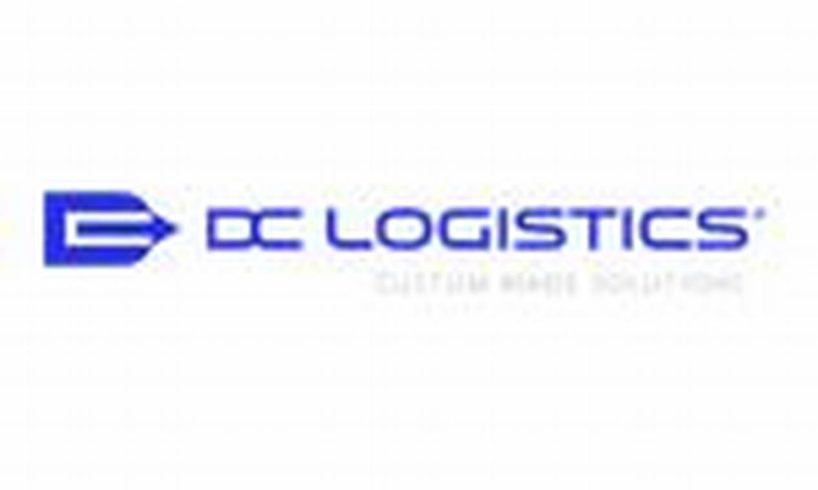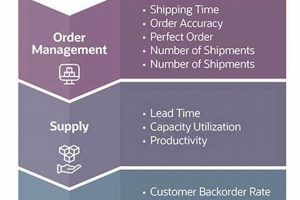
DC logistics tracking refers to the monitoring and management of the movement of goods and resources within a distribution center (DC). It involves tracking inventory levels, order fulfillment, and the flow of goods through the DC using various technologies such as RFID tags, barcode scanners, and inventory management systems.
Effective DC logistics tracking is crucial for efficient warehouse management and supply chain optimization. It provides real-time visibility into the location and status of inventory, enabling businesses to make informed decisions about inventory replenishment, order fulfillment, and resource allocation. This helps reduce lead times, improve customer service, and minimize costs associated with inventory management.
There are several key benefits to implementing DC logistics tracking systems, which include:
- Improved inventory accuracy
- Increased efficiency in order fulfillment
- Reduced lead times
- Better customer service
- Lower inventory carrying costs
DC logistics tracking has evolved over the years, with the adoption of advanced technologies such as RFID and IoT devices. These technologies allow for more accurate and real-time tracking of inventory and resources, providing businesses with greater visibility and control over their supply chains.
1. Inventory Visibility
Inventory visibility refers to the ability to track and monitor inventory levels and their location in real-time. It is a crucial aspect of DC logistics tracking, providing businesses with a clear understanding of the quantity, type, and status of their inventory within the distribution center.
- Accuracy and Control: Inventory visibility ensures accurate inventory records, reducing the risk of stockouts, overstocking, and inventory shrinkage. It empowers businesses to maintain optimal inventory levels, minimize waste, and prevent disruptions in order fulfillment.
- Efficient Order Fulfillment: Real-time inventory visibility enables efficient order fulfillment by providing real-time information on the availability and location of inventory. This helps businesses fulfill customer orders accurately and quickly, reducing lead times and improving customer satisfaction.
- Resource Allocation: Inventory visibility facilitates effective resource allocation within the DC. By tracking inventory movement and identifying areas with high demand, businesses can allocate resources such as staff, equipment, and space more efficiently, optimizing warehouse operations and reducing costs.
- Data-Driven Insights: Inventory visibility provides valuable data and insights into inventory trends, consumption patterns, and stock movement. This data can be analyzed to identify areas for improvement, optimize inventory management strategies, and make data-driven decisions to enhance overall supply chain efficiency.
In summary, inventory visibility is a fundamental component of DC logistics tracking, enabling businesses to gain real-time insights into their inventory, optimize order fulfillment, allocate resources effectively, and make data-driven decisions to improve supply chain efficiency.
2. Order Fulfillment
Order fulfillment is the process of picking, packing, and shipping customer orders in a timely and accurate manner. It is a critical aspect of DC logistics tracking as it involves coordinating the movement of goods from the inventory to the customer.
- Accurate Order Picking: DC logistics tracking systems provide real-time inventory visibility, enabling accurate order picking. Warehouse staff can locate and retrieve the correct items efficiently, minimizing errors and ensuring that customers receive the right products.
- Efficient Packing and Shipping: Tracking systems optimize the packing and shipping process by providing information on item dimensions, weight, and shipping requirements. This helps businesses pack orders efficiently, select the appropriate shipping methods, and generate accurate shipping labels, expediting order delivery.
- Real-Time Order Status Updates: DC logistics tracking keeps track of the status of each order, providing real-time updates to businesses and customers. This transparency enhances communication, manages customer expectations, and facilitates proactive issue resolution.
- Data-Driven Insights: Order fulfillment data can be analyzed to identify patterns, bottlenecks, and areas for improvement. Businesses can use these insights to optimize their order fulfillment processes, reduce lead times, and enhance customer satisfaction.
In summary, DC logistics tracking plays a vital role in order fulfillment by providing real-time visibility, optimizing processes, and generating valuable data for continuous improvement. By leveraging tracking systems, businesses can ensure accurate order picking, efficient packing and shipping, real-time order updates, and data-driven decision-making, ultimately enhancing the overall customer experience.
3. Resource Allocation
Resource allocation is a critical component of DC logistics tracking, as it involves the efficient utilization of resources such as staff, equipment, and space within the distribution center. Effective resource allocation optimizes warehouse operations, reduces costs, and enhances overall supply chain efficiency.
DC logistics tracking systems provide real-time visibility into inventory levels, order fulfillment status, and resource utilization. This information empowers businesses to make informed decisions about resource allocation, ensuring that resources are directed to areas where they are needed most.
For instance, if a particular area of the DC is experiencing high order volumes, the tracking system can identify this demand and allocate additional staff or equipment to that area. This dynamic allocation helps businesses handle peak demand periods effectively, reduce wait times, and improve order fulfillment speed.
Furthermore, DC logistics tracking systems can analyze historical data and identify patterns in resource utilization. This analysis helps businesses optimize their resource allocation strategies in the long term. For example, if a certain type of equipment is consistently underutilized during specific time periods, the business can adjust its resource allocation plan to reduce costs associated with that equipment.
In summary, resource allocation is a crucial aspect of DC logistics tracking that enables businesses to optimize their warehouse operations, reduce costs, and enhance supply chain efficiency. By leveraging real-time data and historical analysis, businesses can make informed decisions about resource allocation, ensuring that resources are utilized effectively to meet customer demand and achieve operational excellence.
4. Real-Time Monitoring
Real-time monitoring is an essential component of DC logistics tracking, providing businesses with up-to-date visibility into the movement and status of inventory, equipment, and personnel within the distribution center. This real-time data enables businesses to make informed decisions, respond to changes, and optimize their operations for greater efficiency and productivity.
One of the key benefits of real-time monitoring is its ability to identify and address potential issues before they escalate. For example, if a particular piece of equipment is experiencing performance issues, real-time monitoring can alert maintenance teams to the problem, allowing them to take proactive steps to prevent a breakdown. This can help minimize downtime, reduce repair costs, and ensure smooth warehouse operations.
Furthermore, real-time monitoring provides businesses with valuable insights into the performance of their DC operations. By tracking key metrics such as order fulfillment times, inventory turnover rates, and equipment utilization, businesses can identify areas for improvement and make data-driven decisions to optimize their processes. This data-driven approach can lead to significant cost savings, improved customer service, and increased overall efficiency.
In summary, real-time monitoring is a critical aspect of DC logistics tracking, providing businesses with the visibility and data they need to make informed decisions, respond to changes, and optimize their warehouse operations. By leveraging real-time monitoring technologies, businesses can improve efficiency, reduce costs, and enhance customer satisfaction.
5. Performance Analytics
Performance analytics is a critical aspect of DC logistics tracking, providing businesses with valuable insights into the efficiency and effectiveness of their distribution center operations. By tracking key performance indicators (KPIs) and analyzing operational data, businesses can identify areas for improvement, optimize processes, and make data-driven decisions to enhance overall supply chain performance.
- Inventory Management: Performance analytics can track inventory turnover rates, stock levels, and lead times, helping businesses optimize inventory levels, reduce carrying costs, and prevent stockouts.
- Order Fulfillment: Tracking order fulfillment metrics such as order cycle times, accuracy rates, and customer satisfaction levels enables businesses to identify bottlenecks, improve order processing efficiency, and enhance customer service.
- Resource Utilization: Performance analytics can monitor equipment utilization rates, labor productivity, and space allocation, helping businesses optimize resource allocation, reduce costs, and improve overall warehouse efficiency.
- Cost Analysis: Tracking logistics costs, including transportation, storage, and labor expenses, provides insights into cost drivers and enables businesses to identify opportunities for cost reduction and optimization.
By leveraging performance analytics in DC logistics tracking, businesses can gain a comprehensive understanding of their operations, make data-driven decisions, and continuously improve their supply chain performance. This leads to increased efficiency, reduced costs, enhanced customer satisfaction, and a competitive advantage in today’s demanding business environment.
6. Cost Optimization
In the realm of distribution center (DC) operations, cost optimization is paramount to maintaining efficiency and profitability. DC logistics tracking plays a vital role in achieving this goal by providing real-time visibility and data that can be leveraged to reduce costs and improve overall supply chain performance.
- Inventory Management: DC logistics tracking enables businesses to optimize inventory levels, reducing carrying costs and preventing stockouts. By tracking inventory turnover rates and stock levels, businesses can identify slow-moving or obsolete inventory and implement strategies to reduce waste.
- Transportation Optimization: Logistics tracking systems provide visibility into transportation costs, including fuel consumption, routing, and carrier performance. Businesses can use this data to negotiate better rates with carriers, optimize routes for efficiency, and reduce overall transportation expenses.
- Labor Optimization: DC logistics tracking can monitor labor productivity and identify areas for improvement. By analyzing data on order fulfillment times, staffing levels, and equipment utilization, businesses can optimize labor allocation, reduce overtime costs, and enhance overall warehouse efficiency.
- Space Utilization: Logistics tracking systems can track space utilization within the DC, identifying areas that are underutilized or overcrowded. This data can be used to optimize warehouse layout, improve storage strategies, and reduce rental costs associated with excess space.
By leveraging DC logistics tracking for cost optimization, businesses can gain a comprehensive understanding of their operations, identify areas for improvement, and make data-driven decisions to reduce expenses. This leads to increased profitability, improved customer service, and a competitive advantage in today’s demanding business environment.
7. Customer Satisfaction
In the realm of distribution center (DC) logistics, customer satisfaction is paramount. DC logistics tracking plays a critical role in enhancing customer satisfaction by providing real-time visibility, improving accuracy, and enabling proactive issue resolution.
- Accurate and Timely Order Fulfillment: DC logistics tracking ensures accurate order picking and efficient order fulfillment processes, reducing errors and delays. This leads to on-time delivery and increased customer satisfaction.
- Real-Time Order Status Updates: Customers can track the status of their orders in real-time through online portals or mobile apps. This transparency builds trust, reduces anxiety, and enhances the overall customer experience.
- Proactive Issue Resolution: Logistics tracking systems generate alerts and notifications when potential issues arise. This allows businesses to proactively address problems, such as stockouts or shipping delays, before they impact the customer. This proactive approach minimizes disruptions and maintains customer satisfaction.
- Personalized Customer Service: DC logistics tracking provides valuable data on customer order history, preferences, and delivery patterns. This data can be leveraged to provide personalized customer service, tailored to individual needs and expectations, ultimately enhancing customer satisfaction and loyalty.
In summary, DC logistics tracking is instrumental in driving customer satisfaction by ensuring accurate and timely order fulfillment, providing real-time order updates, enabling proactive issue resolution, and facilitating personalized customer service. By leveraging logistics tracking technologies, businesses can build strong customer relationships, increase customer retention, and gain a competitive advantage in the market.
8. Data-Driven Insights
In the realm of distribution center (DC) logistics, data-driven insights are a powerful tool for optimizing operations, reducing costs, and enhancing customer satisfaction. DC logistics tracking systems generate a wealth of data that can be analyzed to identify patterns, trends, and areas for improvement.
One of the key benefits of data-driven insights in DC logistics tracking is the ability to optimize inventory management. By analyzing historical data on inventory levels, demand patterns, and lead times, businesses can develop data-driven inventory strategies that minimize stockouts, reduce carrying costs, and improve overall inventory turnover. This leads to increased profitability and better customer service.
Another important application of data-driven insights in DC logistics tracking is in the optimization of order fulfillment processes. By analyzing data on order fulfillment times, error rates, and customer feedback, businesses can identify bottlenecks and inefficiencies in their order fulfillment operations. This data-driven approach enables businesses to make informed decisions about process improvements, resource allocation, and technology investments, leading to faster and more accurate order fulfillment.
Furthermore, data-driven insights play a crucial role in transportation optimization within DC logistics tracking. By analyzing data on transportation costs, carrier performance, and routing efficiency, businesses can identify opportunities to reduce transportation expenses and improve delivery times. This data-driven approach helps businesses optimize their transportation network, negotiate better rates with carriers, and minimize the environmental impact of their supply chain.
In summary, data-driven insights are essential for effective DC logistics tracking. By leveraging the vast amount of data generated by logistics tracking systems, businesses can gain a deep understanding of their operations, identify areas for improvement, and make data-driven decisions to optimize their supply chain performance. This leads to increased efficiency, reduced costs, enhanced customer satisfaction, and a competitive advantage in today’s demanding business environment.
DC Logistics Tracking FAQs
This section addresses frequently asked questions about DC logistics tracking to provide a comprehensive understanding of its significance and benefits.
Question 1: What is the importance of DC logistics tracking?
Answer: DC logistics tracking is crucial for efficient warehouse management and supply chain optimization. It provides real-time visibility into inventory levels, order fulfillment, and the flow of goods, enabling businesses to make informed decisions, reduce lead times, improve customer service, and minimize inventory carrying costs.
Question 2: How does DC logistics tracking improve inventory management?
Answer: DC logistics tracking systems provide real-time inventory visibility, ensuring accurate inventory records, reducing the risk of stockouts and overstocking, and enabling businesses to maintain optimal inventory levels.
Question 3: What role does DC logistics tracking play in order fulfillment?
Answer: DC logistics tracking optimizes order fulfillment by providing real-time inventory visibility for accurate order picking, efficient packing and shipping, real-time order status updates, and data-driven insights for continuous improvement.
Question 4: How does DC logistics tracking contribute to cost optimization?
Answer: DC logistics tracking enables cost optimization through inventory management, transportation optimization, labor optimization, and space utilization. By analyzing data on inventory turnover, transportation costs, labor productivity, and space allocation, businesses can identify areas for cost reduction and improvement.
Question 5: What are the benefits of data-driven insights in DC logistics tracking?
Answer: Data-driven insights from DC logistics tracking systems empower businesses to optimize inventory management, order fulfillment processes, and transportation efficiency. By analyzing historical data and identifying patterns, trends, and areas for improvement, businesses can make informed decisions to enhance their supply chain performance.
Question 6: How does DC logistics tracking enhance customer satisfaction?
Answer: DC logistics tracking contributes to customer satisfaction by ensuring accurate and timely order fulfillment, providing real-time order status updates, enabling proactive issue resolution, and facilitating personalized customer service.
In summary, DC logistics tracking is essential for modern supply chain management, offering numerous benefits that can significantly improve operational efficiency, reduce costs, enhance customer satisfaction, and gain a competitive advantage.
Transitioning to the next article section…
DC Logistics Tracking Tips
Effective DC logistics tracking is crucial for optimizing warehouse operations and supply chain performance. Here are some valuable tips to enhance your DC logistics tracking system:
Tip 1: Leverage Real-Time Tracking TechnologiesImplement real-time tracking technologies such as RFID tags, barcode scanners, and GPS devices to gain real-time visibility into inventory movement and equipment utilization within the DC. This real-time data empowers businesses to make informed decisions and respond quickly to changes in demand or disruptions.Tip 2: Establish Clear Inventory Management ProtocolsDefine clear and standardized inventory management protocols to ensure accurate inventory records and efficient stock management. This includes implementing regular inventory audits, cycle counting processes, and using inventory management software to track inventory levels and prevent stockouts or overstocking.Tip 3: Optimize Order Fulfillment ProcessesUtilize DC logistics tracking to streamline order fulfillment processes by providing real-time inventory visibility for accurate order picking, efficient packing and shipping, and real-time order status updates. This optimization reduces order fulfillment times, improves customer satisfaction, and increases operational efficiency.Tip 4: Data-Driven Decision MakingLeverage the data generated from DC logistics tracking systems to make data-driven decisions about inventory management, resource allocation, and process improvement. Analyze historical data and identify patterns, trends, and areas for improvement to optimize supply chain performance and reduce costs.Tip 5: Continuous Improvement and InnovationContinuously evaluate your DC logistics tracking system and explore new technologies and best practices to enhance its effectiveness. Stay updated with industry trends and advancements to gain a competitive advantage and improve overall supply chain performance.Tip 6: Invest in Training and Staff DevelopmentProvide comprehensive training to staff involved in DC logistics tracking to ensure they understand the importance of accurate data entry, proper equipment usage, and adherence to established protocols. Well-trained staff contributes to the overall efficiency and accuracy of the tracking system.Tip 7: Collaboration and CommunicationFoster collaboration and communication among different departments involved in the supply chain, including inventory management, order fulfillment, and transportation. Effective communication ensures that all stakeholders have access to real-time tracking data and can make informed decisions based on a shared understanding of the supply chain operations.Tip 8: Performance Measurement and KPIsEstablish clear performance metrics and key performance indicators (KPIs) to measure the effectiveness of your DC logistics tracking system. Regularly track and analyze these KPIs to identify areas for improvement and ensure that the system is meeting its objectives.
By implementing these tips, businesses can enhance their DC logistics tracking capabilities, optimize supply chain operations, improve customer satisfaction, and gain a competitive advantage in today’s demanding business environment.
Conclusion…
DC Logistics Tracking
In conclusion, DC logistics tracking plays an indispensable role in modern supply chain management. By implementing effective tracking systems and leveraging real-time data, businesses can gain unprecedented visibility into their distribution center operations. This visibility enables data-driven decision-making, process optimization, and continuous improvement, leading to enhanced efficiency, reduced costs, and increased customer satisfaction.
The future of DC logistics tracking holds exciting prospects, with advancements in technology and the adoption of emerging solutions such as IoT, AI, and blockchain. These technologies promise even greater accuracy, efficiency, and automation in warehouse management, further driving supply chain optimization and competitive advantage.






